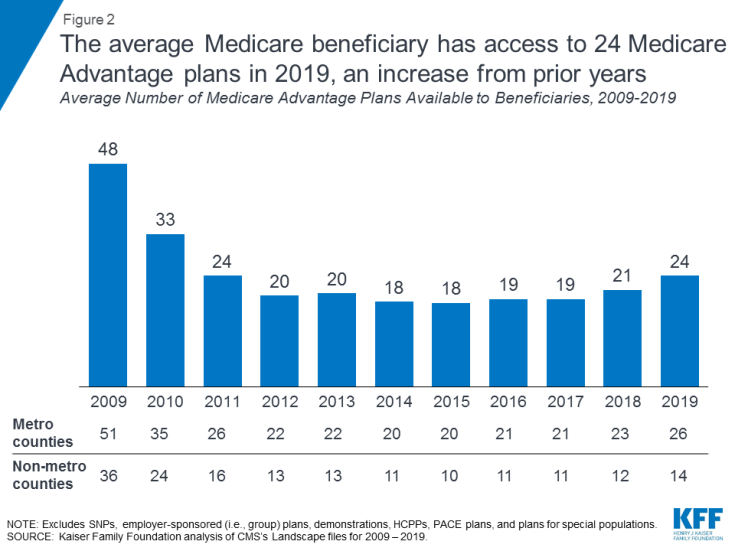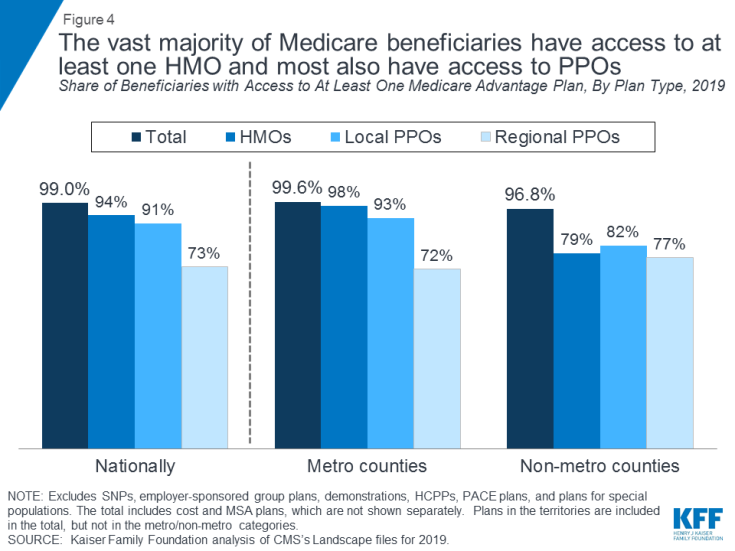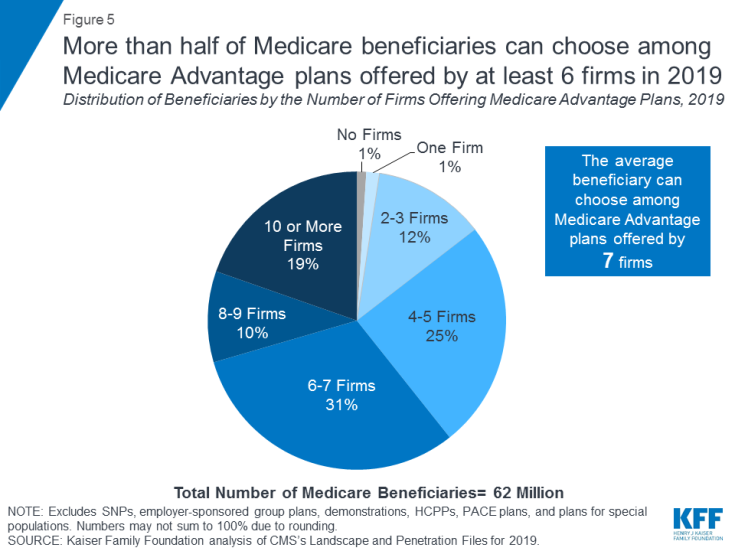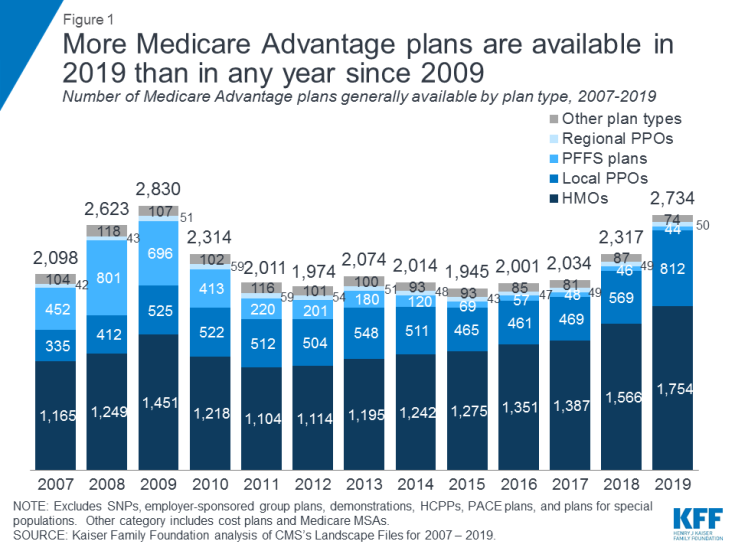Medicare Advantage 2019 Spotlight: First Look
Plan Offerings in 2019
Number of Plans
Total Number of Plans. In total, 2,734 Medicare Advantage plans will be available nationwide for individual enrollment in 2019 – a 18 percent increase (417 more plans) from 2018 and the largest number of plans available since 2009 (Figure 1; Table A1). These numbers exclude employer or union-sponsored group plans and Special Needs Plans, which are only available to select populations. The increase mostly reflects an additional 188 HMOs and 243 local PPOs, with three additional Medical Savings Account (MSA) plans and one additional Regional PPO as well. The size of the increase in local PPOs is notable, and more HMOs and local PPOs will be offered in 2019 than any year since 2007. HMOs continue to account for the majority of plans available, and will account for about two-thirds (64%) of all plans offered in 2019. The growth in number of plans varies across states and counties, with the preponderance of the growth in plans occurring in Florida (75 more plans; data not shown). The District of Columbia and Maine will have fewer plans available in 2019 than in 2018 (with 6 fewer and 1 fewer plans, respectively).
In addition to the new plans available for individual enrollment, more Special Needs Plans (SNPs) will be available in 2019, increasing from 630 plans in 2018 to 717 plans in 2019, reflecting an increase in SNPs for beneficiaries dually eligible for Medicare and Medicaid (D-SNPs; 401 plans in 2018 to 465 plans in 2019) and SNPs for people requiring an institutional-level of care (I-SNPs; 97 plans in 2018 to 125 plans in 2019). The number of SNPs for people with chronic or disabling conditions (C-SNPs) will decline from 132 plans to 127 plans between 2018 and 2019. This decline in C-SNPs may be partly due to both the value-based insurance design (VBID) model with the CMS Innovation Center, which allows plans to reduce cost-sharing or offer supplemental benefits for people with chronic conditions to promote high-value services, and the new authority of Medicare Advantage plans that are open for general enrollment to target supplemental benefits to people with certain chronic conditions beginning in 2019. Both of these expanded authorities allow Medicare Advantage plans to offer benefits to people with chronic conditions that have traditionally been offered through C-SNPs.
While many employers and unions also offer Medicare Advantage plans to their retirees, no information about these plans is made available by CMS to the public during the Medicare open enrollment period.
Number of Plans Available to Beneficiaries. In 2019, the average Medicare beneficiary will have access to 24 Medicare Advantage plans available for individual enrollment, the highest number of plans per beneficiary since 2011 (Figure 2). Among the 24 Medicare Advantage plans available to the average Medicare beneficiary, 20 of the plans will include prescription drug coverage (MA-PDs); 90 percent of all Medicare Advantage plans offered will include prescription drug coverage in 2019.

Figure 2: The average Medicare beneficiary has access to 24 Medicare Advantage plans in 2019, an increase from prior years
Variation in the Number of Plans, by Geographic Area. On average, beneficiaries in metropolitan areas will be able to choose from nearly twice as many Medicare Advantage plans as beneficiaries in non-metropolitan areas (26 plans versus 14 plans, respectively). In six percent of counties (accounting for 30% of beneficiaries), beneficiaries can choose from more than 30 plans in 2019, including four counties in Ohio (Mahoning, Medina, Trumbull, and Summit) and two counties in Pennsylvania (Bucks and Lancaster) where more than 50 plans will be available (Figure 3). In contrast, in 8 percent of counties (accounting for 2% of beneficiaries), beneficiaries can choose from two or fewer Medicare Advantage plans, including 57 counties in which only one plan will be available to beneficiaries. No Medicare Advantage plans will be offered in 115 counties in 2019, down from 149 counties in 2018; these counties account for one percent of beneficiaries, most of whom live in relatively rural areas in California. Eight other states also have counties in which no Medicare Advantage plans will be offered in 2019 (AK, CO, IA, ID, NE, NV, VA, and WA). Additionally, no Medicare Advantage plans are available in territories other than Puerto Rico.
Access to Medicare Advantage Plans, by Plan Type
As in recent years, virtually all Medicare beneficiaries (99%) will continue to have access to a Medicare Advantage plan as an alternative to traditional Medicare (Figure 4). Almost all beneficiaries in metropolitan areas (99.6%) and the vast majority of beneficiaries in non-metropolitan areas (97%) will continue to have access to at least one Medicare Advantage plan, similar to percentages in prior years. In non-metropolitan counties, a smaller share of beneficiaries will have access to HMOs or local PPOs, and a slightly larger share of beneficiaries will have access to regional PPOs.

Figure 4: The vast majority of Medicare beneficiaries have access to at least one HMO and most also have access to PPOs
Number of Firms
The average Medicare beneficiary will be able to choose from plans offered by 7 firms, on average, in 2019, an increase from 6 firms in 2018 (Figure 5). Nearly one in five beneficiaries (19%) will be able to choose from plans offered by 10 or more firms. The number of firms offering Medicare Advantage plans will be highest in Los Angeles County (14 firms), the New York City boroughs of Kings and Queens (14 firms each), and Miami-Dade County (13 firms). In each of these metropolitan counties, per capita spending for the traditional Medicare and the share of beneficiaries enrolled in Medicare Advantage plans are much higher than the national average. In contrast, in 194 counties, most of which are rural counties with relatively few Medicare beneficiaries, only one firm will offer Medicare Advantage plans in 2019, a reduction from 441 such counties in 2018.

Figure 5: More than half of Medicare beneficiaries can choose among Medicare Advantage plans offered by at least 6 firms in 2019
New Market Entrants and Exits
Medicare Advantage continues to be an attractive market for insurers, with 14 firms entering the Medicare Advantage market for the first time in 2019 (Table A2). Seven the new entrants will be offering HMOs available for individual enrollment, one of which will also offer local PPOs. Eight of the new entrants will be offering SNPs, with five entrants offering I-SNPs, four entrants offering D-SNPs, and one offering C-SNPs for people with diabetes or chronic heart failure.
One of the new entrants, Devoted Health, has received venture capital funding, joining about a dozen other venture capital-funded firms offering Medicare Advantage plans in 2019. Lasso Healthcare will offer MSAs in 17 states, many of which have a relatively small share of beneficiaries in Medicare Advantage plans. MSAs operate similar to Health Savings Accounts, and include few (about 6,000) beneficiaries in 2018. Mutual of Omaha, a large insurance corporation, will be entering both the Medicare Advantage market and the stand-alone prescription drug plan (PDP) market for the first time in 2019.
Five insurers will be exiting the Medicare Advantage market in 2019. Four of these insurers offered D-SNPs in 2018, one of which also offered C-SNPs for people with chronic heart failure in 2018. MedStar, a large health care system in the DC metropolitan area, offered Medicare Advantage plans for several years, but will be exiting the Medicare Advantage market in 2019. While these market exits comprise a relatively small share of the insurers in the Medicare Advantage market (with over 200 insurers, including employer/union sponsored plans as well as other plans), the exits are evidence that not all plans in the Medicare Advantage market are profitable. Together, the five insurers exiting the Medicare Advantage market had about 23,000 enrollees in 2018, far less than one percent of the 20 million beneficiaries enrolled in Medicare Advantage in 2018.
Premiums
The vast majority of Medicare Advantage plans for individual enrollment (90%) will include prescription drug coverage (MA-PDs), and about 45 percent of these plans will charge no premium, other the Part B premium, similar to 2018. Nine out of ten beneficiaries (90%) will have access to a MA-PD with no monthly premium in 2019. The average premium for MA-PDs (not weighted by enrollment) will be $40 per month in 2019, down from $46 per month in 2018. Medicare Advantage enrollees typically choose low premium plans, and enrollment-weighted premiums are often lower than the average premium.
Discussion
More Medicare Advantage plans will be offered in 2019 than any year since 2009. While five insurers will be exiting the Medicare Advantage market, they comprise a relatively small share of the insurers offering Medicare Advantage plans, and include about 0.1 percent of Medicare Advantage enrollees. Fifteen insurers will be entering the market for the first time in 2019 – suggesting that the market remains very attractive to insurers. Some parts of the country (such as Florida) continue to be particularly attractive to insurers. As in prior years, some (mostly rural) counties are less attractive to insurers, with fewer firms and plans available. Overall, less than 1 percent of beneficiaries will not have access to a Medicare Advantage plan in 2019, similar to prior years. As Medicare Advantage enrollment continues to grow, insurers seem to be responding by offering more plans and choices to the people on Medicare.
Gretchen Jacobson and Tricia Neuman are with the Kaiser Family Foundation; and Anthony Damico is an independent consultant.

